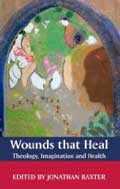 Wounds that Heal: Theology, imagination and health
Wounds that Heal: Theology, imagination and health
Jonathan Baxter, editor
SPCK £15.99 (978-0-281-05830-3)
COLLECTIONS of essays mostly present a challenge for a reviewer. They are usually uneven, often attractively diverse, and generally afford little opportunity for sustained argument. Publishers fear poor sales, and tend to avoid them. In this case, we have a worthwhile book with rich treasure, but a flaw that demands further attention.
The key theme explored here by theorists and practitioners is the interface between health and theology. The reader is asked to reflect on the part played by imagination in the Christian healing ministry. The Centre for the Study of Theology and Health at Holy Rood House in Yorkshire is the context of the writing and dialogue.
Rowan Williams sets out a theology of health, but fails to address some core difficulties in our understanding of what healing might mean. How far will scripture and theology formed essentially in the pre-modern world take us in this quest?
There are essays on ecomysticism, healing and peace, forgiveness, the sacrament of unction, therapy, and music and drama therapy. Essays by Elaine Graham and Grace Jantzen shine out as models of scholarship, with the nourishing depth and insight that comes from attention and engagement. The book stimulates, and gathers in a useful bibliography.
But it would have been improved by a firmer editorial hand. Many of the writers did not have the opportunity to dialogue with others in the flesh, but the editor might have made connections among the essays. Each one could have benefited from an end piece offering a critique from the editor or another reader. Articulating the gaps, contradictions, and inconsistencies would have helped clarify the area, and offer the opportunity to develop the dialogue.
Alas, the flaw reflects an aspect of our Christian lives which has become all too apparent in this field. An ecological model should embrace the biomedical, environmental, personal, socio-political, and spiritual dimensions of health. The book failed to engage in interaction among different aspects of its subject, and left some vital areas out of the discussion altogether, notably the biomedical and economic dimensions of health. Also, there is no apparent interaction with anyone who stands outside the Christian tradition. Such contributions would highlight the strengths and show up the limitations of the religious and theological approaches exemplified here.
Some of the most interesting theological conversations I have had have been with those who are on the outside looking curiously in at us! The Church with its private languages has much to learn from the rest of the world, in its richness and many-faceted wisdom.
The experience most people have today of illness, health, and whole-ness is overwhelmingly shaped by medicine and economics. What has our theology to say about these ideologies? Can we imagine and work towards communities in which our health prospects are not determined by our economic status? We need to model dialogue, and, in doing that, to invite the world in to challenge and change us. This book is a useful start, but we have hardly yet begun to address these challenges.
James Woodward